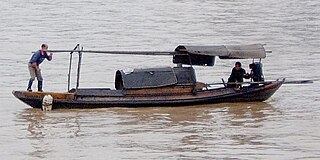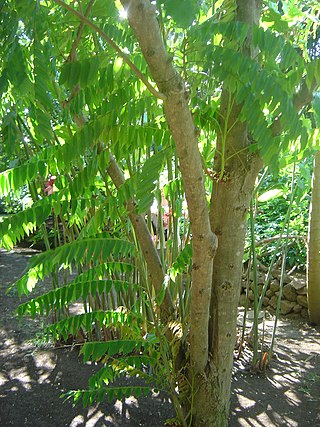Related Research Articles

Calamansi, also known as calamondin, Philippine lime, or Philippine lemon, is a citrus hybrid cultivated predominantly in the Philippines. It is native to the Philippines, parts of Indonesia, Malaysia, and Brunei, as well as parts of southern China and Taiwan.

Rambutan is a medium-sized tropical tree in the family Sapindaceae. The name also refers to the edible fruit produced by this tree. The rambutan is native to Southeast Asia. It is closely related to several other edible tropical fruits, including the lychee, longan, pulasan, and quenepa.

The pomelo, from the family Rutaceae, is the largest citrus fruit, and the principal ancestor of the grapefruit. It is a natural, non-hybrid, citrus fruit, native to Southeast Asia. Similar in taste to a sweet grapefruit, the pomelo is commonly consumed and used for festive occasions throughout Southeast Asia and East Asia. As with the grapefruit, phytochemicals in the pomelo have the potential for drug interactions.

A sampan is a relatively flat-bottomed Chinese and Malay wooden boat. Some sampans include a small shelter on board and may be used as a permanent habitation on inland waters. The design closely resembles Western hard chine boats like the scow or punt. Sampans are generally used for transportation in coastal areas or rivers and are often used as traditional fishing boats. It is unusual for a sampan to sail far from land, as they do not have the means to survive rough weather.

Catechu is an extract of acacia trees used variously as a food additive, astringent, tannin, and dye. It is extracted from several species of Acacia, but especially Senegalia catechu, by boiling the wood in water and evaporating the resulting brew. It is also known as cutch, black cutch, cachou, cashoo, terra Japonica, or Japan earth, and also katha in Hindi, kaat in Marathi, khaira in Odia, khoyer in Assamese and Bengali, and kachu in Malay.

A couch, also known as a sofa, settee, chesterfield, or davenport, is a cushioned item of furniture for seating multiple people. It is commonly found in the form of a bench with upholstered armrests and is often fitted with springs and tailored cushion and pillows. Although a couch is used primarily for seating, it may be used for sleeping. In homes, couches are normally put in the family room, living room, den, or lounge. They are sometimes also found in non-residential settings such as hotels, lobbies of commercial offices, waiting rooms, and bars. Couches can also vary in size, color, and design.
Many languages have words expressing indefinite and fictitious numbers—inexact terms of indefinite size, used for comic effect, for exaggeration, as placeholder names, or when precision is unnecessary or undesirable. One technical term for such words is "non-numerical vague quantifier". Such words designed to indicate large quantities can be called "indefinite hyperbolic numerals".

The word orange is a noun and an adjective in the English language. In both cases, it refers primarily to the orange fruit and the color orange, but has many other derivative meanings.

Averrhoa bilimbi is a fruit-bearing tree of the genus Averrhoa, family Oxalidaceae. It is believed to be originally native to the Maluku Islands of Indonesia but has naturalized and is common throughout Southeast Asia. It is cultivated in parts of tropical South Asia and the Americas. It bears edible extremely sour fruits. It is a close relative of the carambola tree.

Gamboge is a deep yellow pigment derived from a species of tree that primarily grows in Cambodia. Popular in east Asian watercolor works, it has been used across a number of media dating back to the 8th century. Easy to transport and manipulate into a durable watercolor paint, gamboge is notable for its versatility as a pigment in how it has been used in paintings, printing of books, and garment dyes, including the robes of Buddhist monks. Though used in a number of different contexts, Gamboge is known not to react well with citric acid surfaces therefore making it unsuitable for frescos and with white lead. For its popularity, Gamboge has not been extensively identified in works of art from any time period; the few instances wherein art historians have attempted to identify whether or not the pigment was used in a given work have confirmed its widespread use and its longevity as staple within watercolor painting particularly in eastern art.

Areca catechu is a species of palm which grows in much of the tropical Pacific, Asia, and parts of east Africa. The palm is native to the Philippines, but is widespread in cultivation and is considered naturalized in Malaysia, Indonesia, New Guinea, Taiwan, Madagascar, Cambodia, Laos, Myanmar, Thailand, Vietnam, southern China, India, Nepal, Bangladesh, the Maldives, Sri Lanka, parts of the Pacific Islands, and also in the West Indies.

People from the United States of America are known as and refer to themselves as Americans. Different languages use different terms for citizens of the United States. All forms of English refer to US citizens as Americans, a term deriving from the United States of America, the country's official name. In the English context, it came to refer to inhabitants of British America, and then the United States. There is some linguistic ambiguity over this use due to the other senses of the word American, which can also refer to people from the Americas in general. Other languages, including French, Japanese, and Russian, use cognates of American to refer to people from the United States, while others, particularly Spanish and Portuguese, primarily use terms derived from United States or North America. There are various other local and colloquial names for Americans. The name America came from the Italian navigator Amerigo Vespucci.

Hello is a salutation or greeting in the English language. It is first attested in writing from 1826.

Senegalia catechu is a deciduous, thorny tree which grows up to 15 m (50 ft) in height. The plant is called khair in Hindi, and kachu in Malay, hence the name was Latinized to "catechu" in Linnaean taxonomy, as the type-species from which the extracts cutch and catechu are derived. Common names for it include kher, catechu, cachou, cutchtree, black cutch, and black catechu.
References
- Bartlett, Harley Harris (1954), "Malayan Words in English", Michigan Quarterly Review, 60
- Karl-Heinz Best: Malay borrowings in English, in: Glottometrics 31, 2015, p. 50 – 53 (PDF ram-verlag.eu)
- Concise Oxford Dictionary - Tenth Edition of Oxford University Press
- Collins Dictionary, Collins Dictionary
- Dalgado, Sebastiao Rodolfo; Soares, Anthony Xavier (1988), Portuguese Vocables in Asiatic Languages: From the Portuguese Original of Monsignor Sebastiao Rodolfo Dalgado, South Asia Books, ISBN 978-81-206-0413-1
- Douglas Harper (2019), Online Etymology Dictionary
- Editors of Webster's New Dictionaries (2004), Houghton Mifflin 0618396012 Websters II Hardbound New College Dictionary , Houghton Mifflin, ISBN 978-0-618-39601-6
- Dewan Bahasa dan Pustaka (1996), Kamus Dewan (3rd Edition), Dewan Bahasa dan Pustaka, Kementerian Pendidikan, Malaysia, ISBN 983-62-4456-5
- McKenna, Dennis J.; Jones, Kenneth; Hughes, Kerry (2002), Botanical Medicines: The Desk Reference for Major Herbal Supplements, Routledge, ISBN 978-0789012661
- Merriam-Webster, Merriam-Webster dictionary, Merriam Webster Inc.
- Oxford dictionaries, Oxford dictionaries, Oxford University Press, archived from the original on May 16, 2001
- Scott, C.P.G. (1897), "The Malayan Words in English", American Oriental Society
- Waruno Mahdi (2007), Malay Words and Malay Things: Lexical Souvenirs from an Exotic Archipelago in German Publications Before 1700 (Frankfurter Forschungen Zu Sudostasien), Otto Harrassowitz, ISBN 978-3-447-05492-8
- Winger, Jennifer (2000), Manatees and Dugong, Smithsonian National Zoological Park, archived from the original on October 13, 2007
- Yule, Henry; Burnell, Arthur Coke (1999), Hobson-Jobson: The Anglo-Indian Dictionary, Wordsworth Editions Ltd, ISBN 978-1-85326-363-7